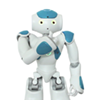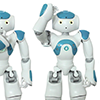The junior research group at the project VICCI considers the software-technical side of so-called “Cyber-physical systems” (CPS). This term includes complex, embedded systems, which connect the virtual and the physical world with each other (see Internet of things) for more efficient processes in different application scenarios. The main uses of CPS are in logistics, traffic optimization, in the use of robots in the industrial and domestic sectors, in modern energy networks (Smart grid), in the building and factory automation (Smart factory), as well as in the field of intelligent office installations (Smart Office).
The aim of project VICCI is the creation of software engineering principles that are necessary for the development of complex cyber-physical systems. Firstly, CPS should be made understandable and accessible by means of a comprehensive control centre. Secondly, platforms that enable the development and marketing of software for complex CPS through a pure control panel are to be developed. A domestic environment is considered a sample scenario in which a person with reduced mobility is supported by sensors, actuators and a service robot, which is currently seen as a complex cyber-physical system.
Domestic-Service-Robot
The chair of Multimedia Technology under the direction of Prof. Dr.-Ing. Raimund Dachselt is thereby involved in the field of Human-Robot-Interaction. While industrial robots act mostly in separated, non-accessible areas, the use of social robots aims directly at getting in contact with humans. The user as well as the robot have to be able to interact and communicate succesfully with each other to accomplish a common goal. The ability of a robot to manipulate (but also to endanger) the “real world” demands a detailled discussion about the social role it will capture reaching far beyond simple input/output mechanisms. The goal is to develop and explore novel interaction techniques. Finally, simple real world applications shall examine the use, performance and finally the acceptance of these new technologies.
Publikationen
@inproceedings{fixme,
author = {Andr\'{e} Viergutz and Tamara Flemisch and Raimund Dachselt},
title = {Increasing the Expressivity of Humanoid Robots with Variable Gestural Expressions},
booktitle = {Proceedings of the ACM/IEEE International Conference on Human-Robot-Interaction},
year = {2014},
month = {3},
location = {Bielefeld},
pages = {314--315},
numpages = {2},
doi = {10.1145/2559636.2559840},
url = {http://dx.doi.org/10.1145/2559636.2559840}
}List of additional material
@inproceedings{fixme,
author = {Tamara Flemisch and Andr\'{e} Viergutz and Raimund Dachselt},
title = {Easy Authoring of Variable Gestural Expressions for a Humanoid Robot (Demo)},
booktitle = {Proceedings of the ACM/IEEE International Conference on Human-Robot-Interaction},
year = {2014},
month = {3},
location = {Bielefeld},
pages = {328},
numpages = {1},
doi = {10.1145/2559636.2559786},
url = {http://dx.doi.org/10.1145/2559636.2559786}
}List of additional material
- Find more at vicci.eu


